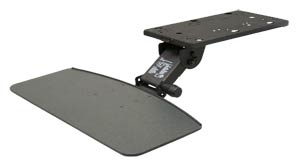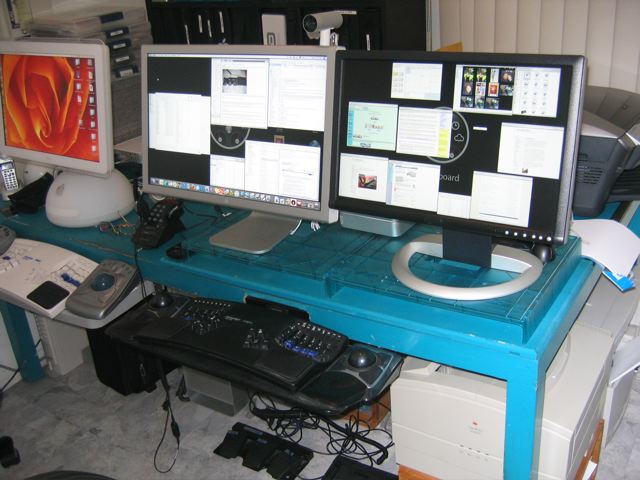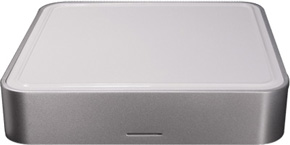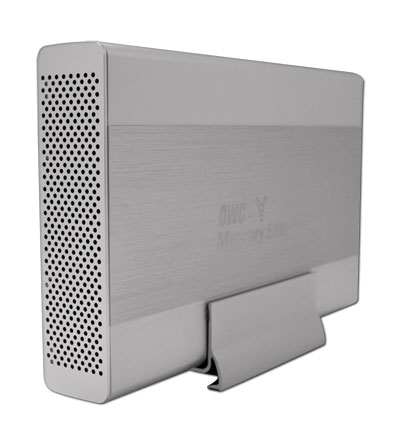Hardware for Writing
The Keyboard
I have a fantastic keyboard – the Kinesis Advantage. It is supremely comfortable. It is available in the United States. I have three of them: one for me, one for Camille, and one under the desk as a backup. Each one costs about $300. The keyboard itself is much more important than the actual computer I use. I am continually touching the keyboard, and keyboards can potentially ruin your hands, injure them to the point that you will be unable to type. If you are a writer, it is slightly insane to use a regular keyboard.

The Keyboard Layout (Arrangement of the keys themselves)
The one I use is Dvorak/Qwerty switchable. I type with the Dvorak layout, which puts all the most commonly used letters right under your fingertips, in the middle of the keyboard. By the way, if you are going to do any writing at all, learn to touch type so that you never have to look at the keyboard. The Dvorak keyboard layout is quite superior, and I made the switch in 1998, after 30 years of typing in Qwerty.

The black letters are Dvorak, the little red letters are the Qwerty.
If you look at your keyboard more than once every two minutes, why not just switch to the dvorak and really learn to type? All that hunching over is going to ruin your neck, and that is going to pinch a nerve, and that is going to make your hands hurt. Or something. Hunching over is over.
The Keyboard Tray
The keyboard is on a keyboard tray, which keeps it at exactly the right height and is easily adjustable. If you type many hours a day, you must have an adjustable keyboard tray.


A keyboard tray is an essential. This costs about $200 and is totally worth it.
Footpedals
Footpedals let you put your most-used commands on the floor. They are programmable – just tap a couple of keys, then tap the key you want to put on the floor. to the floor.

This means that when I hit any key modifier – on a Macintosh, the command key the option key, shift key, I use my feet. Also Page Up and Page Down are on the floor, which gives me a second to lean back and stretch as I scroll through what I just wrote. And the Carriage Return or Enter key is on the floor.
These are made by Kinesis. The triple-action pedals on the left, in one unit, plug into the back of the Kinesis keyboard and are seen by the computer as part of the keyboard. These are the easiest to reprogram. The pedals on the right are USB, and can be used with any modern computer, no matter what brand of keyboard you have.
Monitors
It is important to be able to see your work. Getting a larger monitor is one of the most effective ways to improve your productivity, because you can see what you are working on, see your reference material, and have your notes all visible.

On the far left is Camille's iMac. The other two monitors go with my G5, which is under the desk. On the right is a Dell 20 inch LCD that cost $500, and in the middle is an Apple 23 inch that cost about $1000. They are both great monitors.
So - if you are writing more than 4 hours a day, consider that you really should have the right equipment. You can get a fantastic ergonomic setup for less than $2000, not including the computer. If you are writing, you can do just fine on an old computer.
But you can't replace your hands.
The Computer Itself
My main computers, currently, are a Macbook Pro (the main maichine), an Air (mostly for travel, and also for dictation with Dragon Dictation), and a 4-year old Mac G5 tower with 8 GB RAM. I tend to buy the middle of the line Mac tower, give it lots of RAM, and use it for 4 or 5 years. I never buy the newest version, usually waiting at least a year to let everything get refined.
I typically have 15 programs open simultaneously – four different text processors, an HTML editor, an email program, a web browser, iTunes, iChat, a couple of image or photo browsers, an FTP program.
In the last 10 years, with many thousands of web pages visited and emails received, the Mac has never gotten a virus, worm, or any other infection.
In case you ever wonder why people love Macs, re-read the above four paragraphs.
What you need as a writer is for your computer to be almost transparent, making it easy for you to record and preserve your words.
You can buy a $300 used computer and do just fine. More important than the computer itself is your backup system. It needs to be totally effortless to have multiple, redundant backups of all your work, all your emails, all your notes, and all your manuscripts.
Your Backup System
To be totally relaxed as a writer, able to focus just on your work, you need to know that you have backups of everything. Even if your computer crashes, you can if necessary just switch to another computer, because everything you need is cloned on hardware that is OUTSIDE your computer itself.
For quick backups, get a USB flash drive (amazon link). I use 4 to 16 GB models usually, which lets me put my current projects on a stable external widget that I can carry around in my pocket.

External Hard Drives
You need to have an external hard drive in its own case, either USB 2 or Firewire, or both. Pay at least $90 or so just for the case. Then buy a hard drive separately. Get the best case – this is your main backup. You can buy them together, but make sure it is not a generic, piece-of-junk hard drive thrown in there.
Your external hard drive system is for backing up your entire system – everything that is of value.
I have 8 or so of these 750 GB to 1 TB miniStacks, because they are cute and my wife likes them and therefore likes keeping them right near our computers and is more likely to use them. I keep 3 of them off site, stashed in various places. The others rotate as daily, weekly and monthly backups.
On
These are OWC - Newer Technology


I bought some of the miniStacks with included, already-assembled 250 or 400 Gig hard drives. I called and asked about the specific hard drive, and approved of the brand. Others I assembled myself, a very simple task. I am a big fan of Seagate hard drives, because they run quiet and cool and come with a longer warranty.
Below is an OWC Mercury Elite external hard drive case. I have four of them and rotate hard drives through them. Two of them sit behind my computer, for the backup from last week and last month, and two of them are offsite. It is very easy to pop a new hard drive into one of these cases. The cases just always work. That is what you need with your backups – total reliability.

Expect to pay at least $300 for multiple redundant external hard drive backup systems.
Several weeks ago, I called a friend to suggest we get together and I'd show him some computer tips. I knew that he just started an online magazine in addition to the several print magazines he publishes. I bought one of the 250 Gig miniStacks for him. He didn't have time to see me and put me off. Then his hard drive crashed and he lost almost everything. This took so much of his time that he has not had time to come over and have me show him how easy, almost effortless it is to have a total backup of his entire hard drive, one that is bootable and portable. He can clone his entire system – everything – to an external, and then if needs be, swap hard drives. Even swap the hard drive from his external case into a brand-new computer and have the brand-new computer have EVERYTHING - every email, every program, every serial number, every file, a perfect working copy of everything.
We are in a new world here, folks, with fast, cheap, reliable, swappable hard drives. Take advantage of it.